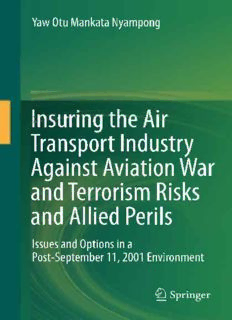
Insuring the Air Transport Industry Against Aviation War and Terrorism Risks and Allied Perils: Issues and Options in a Post-September 11, 2001 Environment PDF
Preview Insuring the Air Transport Industry Against Aviation War and Terrorism Risks and Allied Perils: Issues and Options in a Post-September 11, 2001 Environment
Insuring the Air Transport Industry Against Aviation War and Terrorism Risks and Allied Perils . Yaw Otu Mankata Nyampong Insuring the Air Transport Industry Against Aviation War and Terrorism Risks and Allied Perils Issues and Options in a Post-September 11, 2001 Environment YawOtuMankataNyampong FacultyofLaw McGillUniversity Montreal Que´bec Canada ISBN978-3-642-32432-1 ISBN978-3-642-32433-8(eBook) DOI10.1007/978-3-642-32433-8 SpringerHeidelbergNewYorkDordrechtLondon LibraryofCongressControlNumber:2012954862 #Springer-VerlagBerlinHeidelberg2013 Thisworkissubjecttocopyright.AllrightsarereservedbythePublisher,whetherthewholeorpart of the material is concerned, specifically the rights of translation, reprinting, reuse of illustrations, recitation,broadcasting,reproductiononmicrofilmsorinanyotherphysicalway,andtransmissionor informationstorageandretrieval,electronicadaptation,computersoftware,orbysimilarordissimilar methodologynowknownorhereafterdeveloped.Exemptedfromthislegalreservationarebriefexcerpts inconnectionwithreviewsorscholarlyanalysisormaterialsuppliedspecificallyforthepurposeofbeing enteredandexecutedonacomputersystem,forexclusiveusebythepurchaserofthework.Duplication ofthispublicationorpartsthereofispermittedonlyundertheprovisionsoftheCopyrightLawofthe Publisher’s location, in its current version, and permission for use must always be obtained from Springer.PermissionsforusemaybeobtainedthroughRightsLinkattheCopyrightClearanceCenter. ViolationsareliabletoprosecutionundertherespectiveCopyrightLaw. The use of general descriptive names, registered names, trademarks, service marks, etc. in this publicationdoesnotimply,evenintheabsenceofaspecificstatement,thatsuchnamesareexempt fromtherelevantprotectivelawsandregulationsandthereforefreeforgeneraluse. While the advice and information in this book are believed to be true and accurate at the date of publication,neithertheauthorsnortheeditorsnorthepublishercanacceptanylegalresponsibilityfor anyerrorsoromissionsthatmaybemade.Thepublishermakesnowarranty,expressorimplied,with respecttothematerialcontainedherein. Printedonacid-freepaper SpringerispartofSpringerScience+BusinessMedia(www.springer.com) Foreword IampleasedtowelcomethepublicationofthisworkbyDr.Nyampong,acolleague attheInstituteofAirandSpaceLawatMcGillUniversityinMontreal. Thisworkprovidesacarefulanddetailedanalysisoftheinsuranceimplications of the tragic events of September 11, 2001, involving the terrorist attack on the World Trade Center in New York. It includes discussion of the history, structure and workings of the international insurance market which provides cover against the risks ofaviationwar and terrorism,the impact ofthe events of September 11, 2001onthe aviation warandterrorisminsurance market,andtheresponseonthe partoftheinsurersofsaidriskstoSeptember11,includingtheformsandlimitsof coveragecurrentlyavailableinthemarketinrespectofsuchrisks. September 11, 2001 brought to light certain fundamental problems inherent in the insurance of aviation war and terrorism risks. In the 11 years that have since elapsed, many initiatives have been proposed (some even implemented) at the national,regionalandinternationallevelstoaddresstheseproblems.Unfortunately, however,apermanentandsustainablesolutiontotheproblemhasnotbeenfoundas yet,anditisfearedthatthecommercialaviationinsurancemarket(whichcontinues to provide primary insurance coverage for such risks) may not have the requisite capacity to bear the financial consequences of another large terrorist attack that involvestheairtransportsystem. This work makes a significant contribution to the search for a permanent and sustainable solution to the problem by carefully analyzing and exploring the root causesthereoffromamultidisciplinaryperspective.Insodoing,thebooktracesthe rationale underlying the historical exclusion of war and terrorism risks from property/casualty and marine insurance contracts, and examines the manner in which these exclusionary practices were subsequently extended to, and have since evolved in, the aviation insurance market. Aside from insurance, this work alsoanalyzesotherdifferenttraditionalandinnovativemechanismsofrisktransfer andriskmanagementtodeterminewhethertheyareperhapsbettersuitedtoprovide permanentandsustainablecoverageforaviationwarandterrorismrisks.Thework concludes by identifying and proffering a number of recommendations on how to achievepermanentandsustainablecoverageofaviationwarandterrorismrisks. v vi Foreword I commend this book to all who have a practical, legal or academic interest in aviation insurance, including particularly those with an interest or involvement in theinsuranceaspectsofaviationwarandterrorismrisks. LosAngeles RodMargo September2012 Preface The saying that the terrorist events of September 11, 2001, changed the world forever is true not only in respect of how it changed the conduct of international relations between states but also in respect of the manner in which it affected the provisionofinsurancecoverageforaviationwarandterrorismrisks.Althoughthe quantumoflossandcompensationthatinsurershadtopayasaresultoftheevents ofSeptember11,2001,wasunprecedented,eventsofsuchnaturewerenotentirely newtotheinsurancemarketparticularlytheLondonaviationmarketwherecover- ageofaviationwarandterrorismriskswascommonlyprovided.Indeed,the1968 IsraeliattackonBeirutairportisonrecordasthefirstmajoreventofthatnaturethat targeted the international air transport system. This marked the beginning of the exclusion of war and allied risks from aviation insurance policies issued in the Londonmarket,apracticethatwassuccessivelyexpandedanddevelopedasmany more such events occurred over time. A few days after the fateful events of September 11, 2001, however, it became abundantly clear to everyone who had something to do with the air transport industry that the business-as-usual era in whichairlinescouldobtainfromcommercialinsurersasmuchinsurancecoverage foraviationwarandterrorismrisksastheydesiredwasoverandthatthetimehad come to begin the difficult process of finding other reliable risk transfer mechanismstoserveasalternativesand/orcomplementstotraditionalinsurance. A review of the literature at the time indicated that the question of how to provideorensuretheprovisionofsustainableinsurance(orotherfinancial)cover- ageforaviationwarandterrorismriskshadnotbeenaddressedinacomprehensive manner by academicians, insurance practitioners, and government policymakers. Whatreallycomplicatedtheissueisthefactthat,inmostcountries,thelawrequires an air transport operator to maintain adequate insurance coverage (including cov- erageforwarandterrorismrisks)asaconditionfortheinitialgrantandcontinuing validity of an air operator’s certificate. There being no mechanism to ensure that what the law requires as minimum insurance requirements would be available commercially or otherwise to airlines, events such as those of September 11, 2001, almost brought the global air transport industry to a halt. Proposals of all kindandmannerwereadvanced,drivenbytheurgentdesiretofindasolutiontothe vii viii Preface problem and the tendency to transpose solutions that have been successfully implementedinotherareasofeconomicendeavor.Unfortunately,verylittleeffort wasdirectedtowarddeterminingwhattherootcause(s)oftheproblemwere.Asa result,mostofthesolutionsthatwereimplementedhaveeitherfailedorremained stillborn. Inlightoftheforegoing,therationaleunderlyingmyresearchandultimatelythis bookwas totakeastep back andlook criticallyat theproblemofhow toprovide sustainableinsurancecoverageforaviationwarandterrorismrisks,notonlyfroma legal perspective but also taking into account various other nonlegal phenomena thatcouldhelpdelineatetheexactboundariesoftheproblembeforeprescribingany solutions.Inordertodoso,itwasimportantasafirststeptoprovidereaderswithan overviewofaviationinsuranceaspracticedintheLondonmarket(and,subjectto some marked differences in a few places, throughout the wider Common Law world). This is followed by a specific focus on how the commercial insurance market has addressed marine and subsequently aviation war and terrorism risks over the years. The book then analyzes the behavior of the commercial insurance marketstoextremeeventssuchasSeptember11,2001,byresortingtoanumberof concepts and models propounded by eminent scholars in the fields of law and economicsas well as behavioral law and economics.One ofthe major findings is that as a means of risk management, insurance works best under circumstances where the law of large numbers applies—large population size characterized by highfrequencyofoccurrenceoftheriskconcernedbutasignificantlylowfinancial impact on each occurrence. Aviation war and terrorism risks on the other hand belongtotheclass ofrisks thatare typicallylowfrequency/highfinancial impact. Assuch,insurerappetiteforthosetypesofrisksdecreasesasthesizeofthelatest occurrence(payout)increases. Clearly,ifthecommercialinsurancemarketsalonecannotbeexpectedtoinsure these risks at societally desirable levels and in a sustainable fashion, then it is imperative that alternatives and complementary solutions be found. The book therefore considers the extent to which capital markets, governments, and the international community of states (three of the many proposed solutions) may provide alternative or complementary mechanisms to the coverage of aviation warandterrorismrisksbycommercialinsurers.Eachoftheseraisespeculiarissues which are discussed from a multidisciplinary perspective. Thus government-run insurance and guarantee schemes for air transport operators in a number of countries are analyzed along with the numerous issues associated therewith. For instance,ithasbeenallegedthatadomesticwarandterrorisminsurancemarketfor air transport operations has not been able to develop due mainly to the federal government’s continued provision of premium war riskinsurance coverage toUS airlines. At the international level, most states consider that aviation war and terrorismrisks areadirectmanifestation ofeachstate’sforeignpolicy. Assuch it has been difficult to develop an international mechanism that will address the insuranceandfinancialaspects ofsuch riskstothesatisfactionofall(orat leasta majority of) states. Capital market solutions on the other hand offer unique opportunitiesanddeepercapitalreservesfortheinsuranceofsuchrisks.However, Preface ix itisimportanttotreadwithcautionandtolearnlessonsfromtherecenteconomic crisis. It is my hope that this exposition will enable policymakers, decision makers, governmentregulators,airtransportoperators,airlines,andtheirinsurerstohavea broaderview ofwhataviationwarandterrorismriskinsurancereallyentails.Itis intended to encourage and facilitate discussion and reflection about the way forward. Montreal,QC,Canada YawOtuMankataNyampong
Description: